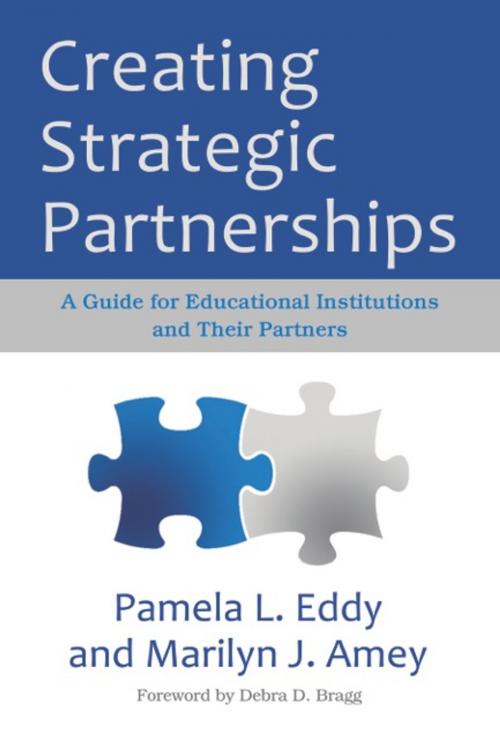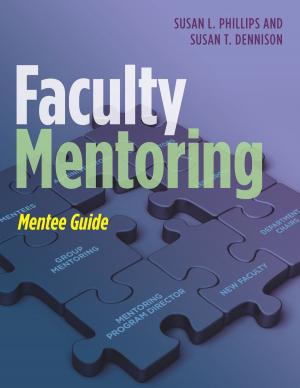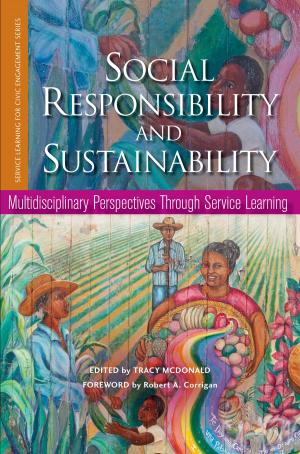Creating Strategic Partnerships
A Guide for Educational Institutions and Their Partners
Nonfiction, Reference & Language, Education & Teaching, Higher Education| Author: | Marilyn J. Amey, Pamela L. Eddy | ISBN: | 9781579227579 |
| Publisher: | Stylus Publishing | Publication: | August 30, 2015 |
| Imprint: | Stylus Publishing | Language: | English |
| Author: | Marilyn J. Amey, Pamela L. Eddy |
| ISBN: | 9781579227579 |
| Publisher: | Stylus Publishing |
| Publication: | August 30, 2015 |
| Imprint: | Stylus Publishing |
| Language: | English |
What are the characteristics and conditions that lead to successful educational partnerships?
What can we learn from partnerships that fail, cannot be sustained over time, or cease to benefit their partners?
This book serves as a guide to the successful implementation of partnerships. It provides the context and tools for readers who are responding to the increasing demands of policy makers, funders and institutional leaders to use partnerships to address local, state and federal issues, achieve external mandates, meet public or internal agendas, or pursue international collaborations.
This guide provides an evidence-based framework for institutional and organizational leaders to develop the vision, shared values and norms to achieve the “partnership capital” that will sustain an enduring relationship. It offers a three-phase model of the development process of collaboration, together with a tool box for those charged with partnering and leading organizational change, and includes a template for both creating new partnerships and sustaining existing ones.
The authors start by differentiating between “traditional,” often ad-hoc, partnerships and “strategic partnerships” that align organizational strategy with partnership actions; and by identifying the importance of moving beyond incremental or surface “first order” change to develop deep “second order change” through which underlying structures and operations are questioned and new processes emerge due to the partnership. They offer analyses and understandings of seven key components for success: exploring motivations; developing partner relationships; communicating and framing purpose; creating collaborative structures and resources; leading various partnership stages; generating partnership capital; and implementing strategies for sustaining partnerships.
Each chapter concludes with a case study to provide more understanding of the ideas presented, and for use in training or classes.
This guide is addressed to policy makers and educational leaders, college administrators, and their non-profit and business partners, to enable them to lead and create strategic partnerships and facilitate organizational change
What can we learn from partnerships that fail, cannot be sustained over time, or cease to benefit their partners?
This book serves as a guide to the successful implementation of partnerships. It provides the context and tools for readers who are responding to the increasing demands of policy makers, funders and institutional leaders to use partnerships to address local, state and federal issues, achieve external mandates, meet public or internal agendas, or pursue international collaborations.
This guide provides an evidence-based framework for institutional and organizational leaders to develop the vision, shared values and norms to achieve the “partnership capital” that will sustain an enduring relationship. It offers a three-phase model of the development process of collaboration, together with a tool box for those charged with partnering and leading organizational change, and includes a template for both creating new partnerships and sustaining existing ones.
The authors start by differentiating between “traditional,” often ad-hoc, partnerships and “strategic partnerships” that align organizational strategy with partnership actions; and by identifying the importance of moving beyond incremental or surface “first order” change to develop deep “second order change” through which underlying structures and operations are questioned and new processes emerge due to the partnership. They offer analyses and understandings of seven key components for success: exploring motivations; developing partner relationships; communicating and framing purpose; creating collaborative structures and resources; leading various partnership stages; generating partnership capital; and implementing strategies for sustaining partnerships.
Each chapter concludes with a case study to provide more understanding of the ideas presented, and for use in training or classes.
This guide is addressed to policy makers and educational leaders, college administrators, and their non-profit and business partners, to enable them to lead and create strategic partnerships and facilitate organizational change
What are the characteristics and conditions that lead to successful educational partnerships?
What can we learn from partnerships that fail, cannot be sustained over time, or cease to benefit their partners?
This book serves as a guide to the successful implementation of partnerships. It provides the context and tools for readers who are responding to the increasing demands of policy makers, funders and institutional leaders to use partnerships to address local, state and federal issues, achieve external mandates, meet public or internal agendas, or pursue international collaborations.
This guide provides an evidence-based framework for institutional and organizational leaders to develop the vision, shared values and norms to achieve the “partnership capital” that will sustain an enduring relationship. It offers a three-phase model of the development process of collaboration, together with a tool box for those charged with partnering and leading organizational change, and includes a template for both creating new partnerships and sustaining existing ones.
The authors start by differentiating between “traditional,” often ad-hoc, partnerships and “strategic partnerships” that align organizational strategy with partnership actions; and by identifying the importance of moving beyond incremental or surface “first order” change to develop deep “second order change” through which underlying structures and operations are questioned and new processes emerge due to the partnership. They offer analyses and understandings of seven key components for success: exploring motivations; developing partner relationships; communicating and framing purpose; creating collaborative structures and resources; leading various partnership stages; generating partnership capital; and implementing strategies for sustaining partnerships.
Each chapter concludes with a case study to provide more understanding of the ideas presented, and for use in training or classes.
This guide is addressed to policy makers and educational leaders, college administrators, and their non-profit and business partners, to enable them to lead and create strategic partnerships and facilitate organizational change
What can we learn from partnerships that fail, cannot be sustained over time, or cease to benefit their partners?
This book serves as a guide to the successful implementation of partnerships. It provides the context and tools for readers who are responding to the increasing demands of policy makers, funders and institutional leaders to use partnerships to address local, state and federal issues, achieve external mandates, meet public or internal agendas, or pursue international collaborations.
This guide provides an evidence-based framework for institutional and organizational leaders to develop the vision, shared values and norms to achieve the “partnership capital” that will sustain an enduring relationship. It offers a three-phase model of the development process of collaboration, together with a tool box for those charged with partnering and leading organizational change, and includes a template for both creating new partnerships and sustaining existing ones.
The authors start by differentiating between “traditional,” often ad-hoc, partnerships and “strategic partnerships” that align organizational strategy with partnership actions; and by identifying the importance of moving beyond incremental or surface “first order” change to develop deep “second order change” through which underlying structures and operations are questioned and new processes emerge due to the partnership. They offer analyses and understandings of seven key components for success: exploring motivations; developing partner relationships; communicating and framing purpose; creating collaborative structures and resources; leading various partnership stages; generating partnership capital; and implementing strategies for sustaining partnerships.
Each chapter concludes with a case study to provide more understanding of the ideas presented, and for use in training or classes.
This guide is addressed to policy makers and educational leaders, college administrators, and their non-profit and business partners, to enable them to lead and create strategic partnerships and facilitate organizational change















